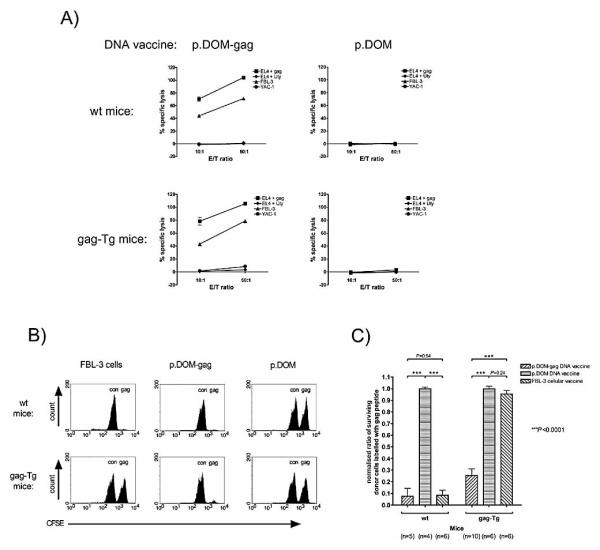Figure 5.

DNA vaccination of gag-Tg mice induces gag85-93-specific effector CTL capable of in vitro and in vivo cytolytic activity. WT and gag-Tg mice were immunized with p.DOM-gag or p.DOM DNA vaccines, or irradiated FBL-3 cells, as indicated, on days 0 and 28. (A) At day 36, splenocytes were cultured with 0.01 M gag85-93 peptide for 6 days in vitro, prior to measuring CTL activity by standard 51Cr-release assay. Targets were EL4 cells pulsed with gag85-93 peptide or control peptide (Uty), FBL-3 leukemia cells expressing endogenous FMuLVgag antigen, or the control cell line YAC-1. Representative data from individual mice are shown; data from one of two identical experiments are shown; error bars: SEM. (B, C) At day 36 following vaccination, mice were infused, by intravenous injection, with a 1:1 mixture of target splenocytes: one population of cells had been pulsed with gag85-93 (gag) peptide while the other had been pulsed with control (con) peptide (SNWYFNHL); each population was labeled with a different concentration of CFSE (gag85-93 peptide: CFSEhi; control peptide: CFSElow). Splenocytes were harvested 20 h later and the frequency of each CFSE-labeled target cell population determined by flow cytometric analysis. (B) Representative flow cytometric profiles from individual mice. (C) The ratio of gag85-93- to control peptide-pulsed cells surviving in each recipient was calculated. The ratios were normalized, by assuming that the mean ratio was 1:1 in mice given the control vaccine (p.DOM), and pooled to calculate the mean proportion of surviving donor cells pulsed with the gag85-93 peptide, together with the SEM (error bars). Data are pooled from two of two identical experiments, each giving similar results; the number (n) of animals pooled per group is indicated.
